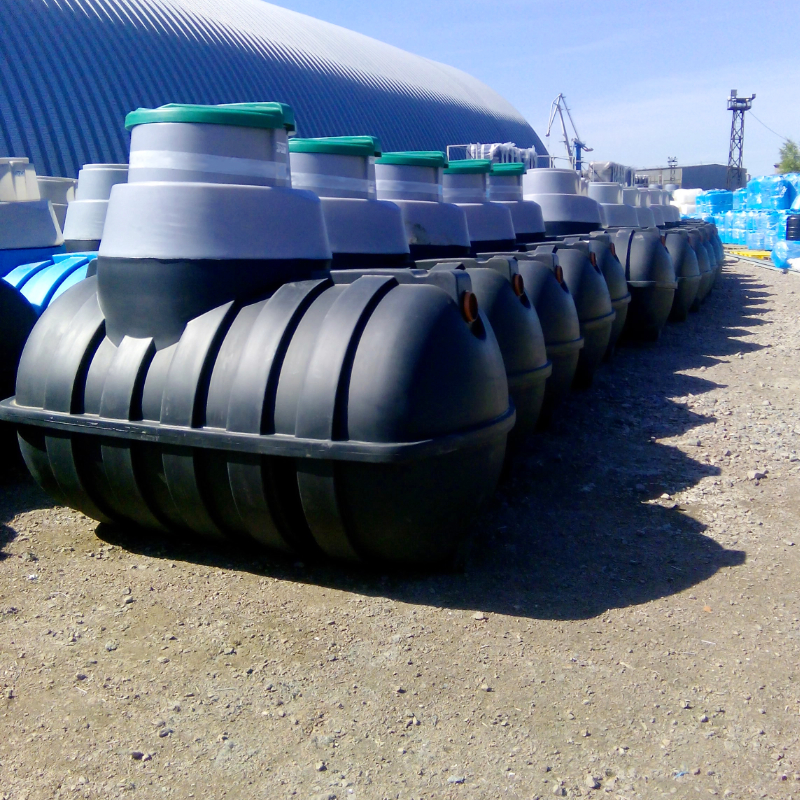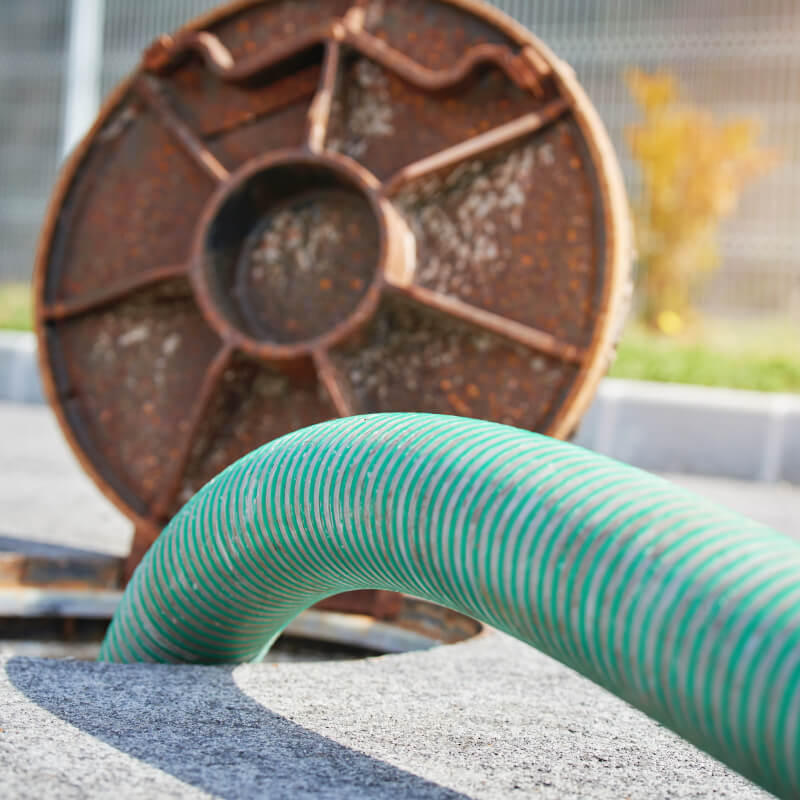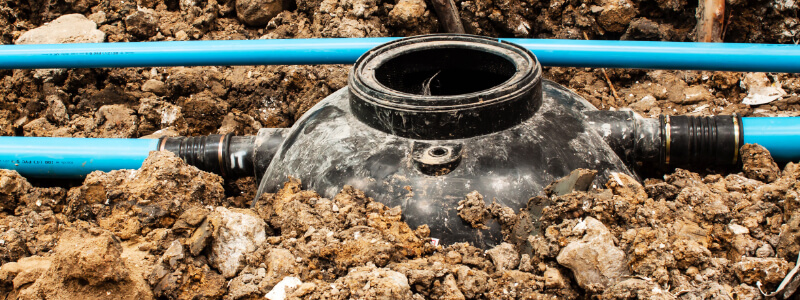In this article
What is the process of emptying a septic tank?
When it comes to maintaining a healthy and functional septic system, one crucial task often stands out: emptying the septic tank. Understanding the ins and outs of this process is essential for ensuring the longevity and efficiency of your plumbing infrastructure. Regular maintenance is paramount to upholding the functionality and longevity of your septic system, so what is the process of emptying a septic tank?
In this blog post, we delve into the intricacies of emptying a septic tank, exploring the steps, considerations, and best practices involved in this vital maintenance procedure.
How does a Septic Tank work?
To understand how emptying septic tanks works, knowing how they function is essential. Look at septic tank systems and how they help your household drainage.
- Wastewater Collection: Wastewater from toilets, sinks, showers, and laundry drains flows into the septic tank through the inlet pipe.
- Separation Process: Once inside the septic tank, the wastewater is separated. Solid waste settles at the bottom of the tank as sludge, while lighter materials like oil and grease float to the top as scum.
- Biological Treatment: Within the septic tank, anaerobic bacteria break down the organic solids present in the wastewater, partially treating the effluent before it exits the tank.
- Effluent Discharge: The partially treated liquid effluent exits the septic tank via the outlet pipe, leading to the drain field for further treatment and absorption into the soil.
Components of a Septic System:
- Septic Tank: The primary component of the septic system is a watertight container typically made of concrete, fibreglass, or plastic. It holds the wastewater long enough for solids to settle and be partially decomposed by bacteria.
- Inlet and Outlet Pipes: The inlet pipe connects the household plumbing to the septic tank, allowing wastewater to enter. The outlet pipe carries partially treated effluent from the septic tank to the drain field for final treatment.
- Baffle: Located inside the septic tank, the baffle prevents scum and solids from exiting the tank with the effluent, ensuring only liquid effluent flows to the drain field.
- Drain Field: Also known as the leach field, the drain field consists of perforated pipes buried in trenches filled with gravel or other suitable material. The effluent from the septic tank disperses into the drain field, where it undergoes further treatment through natural processes in the soil.
- Soil: The soil in the drain field acts as a natural filter, removing harmful bacteria and pathogens from the effluent before it re-enters the groundwater.
Why Regular Emptying Matters
One of the fundamental aspects of septic tank maintenance is periodic emptying to remove accumulated solids and sludge. This process is vital for preventing blockages, maintaining proper drainage, and prolonging the septic system's lifespan.
Prevent Costly Repairs:
Neglecting septic tank maintenance can lead to clogs, backups, and system failures, resulting in expensive repairs or replacements. Regular upkeep helps identify issues early, saving you from significant financial burdens.
Protect Health and Environment:
A well-maintained septic system effectively treats wastewater, preventing contamination of groundwater and surface water sources: proper maintenance safeguards your family's health and the surrounding environment.
Ensure System Efficiency:
Over time, solid waste accumulates in the septic tank, reducing its capacity and efficiency. Routine maintenance, including emptying the tank when necessary, helps maintain optimal performance and prevents overflows or backups.
So, what is the process of emptying a septic tank?
- Tank Inspection:
- A thorough visual inspection of the septic tank is conducted to evaluate its overall condition.
- Professionals check for any signs of damage, leaks, or corrosion within the tank and its components.
- Access ports are inspected to ensure they are securely sealed, preventing leaks during the pumping process.
- Pumping Out Waste:
- Using specialised vacuum trucks or pumping equipment, the septic tank's contents are extracted meticulously.
- The extraction process includes removing solid waste (sludge) and liquid effluent from the tank.
- Careful attention is given to prevent disturbance to settled sludge at the tank's bottom, ensuring thorough waste removal.
- Sludge Removal:
- Professional technicians focus on efficiently removing accumulated sludge, a critical element for effective emptying.
- Tools and equipment are skillfully utilised to agitate and eliminate the sludge, preventing future blockages and issues.
- Cleaning the Tank:
- Following the waste removal, the interior of the septic tank undergoes a comprehensive cleaning process.
- High-pressure water or appropriate cleansing methods are employed to rinse the tank walls, baffles, and pipes, eliminating residual debris.
- Access ports are cleaned thoroughly and securely sealed post-cleaning to maintain their integrity and prevent odours or leaks.
- Final Checks and Maintenance:
- A final inspection confirms that the septic tank is free of any remaining waste or debris.
- Tank components are scrutinised for damages or wear that may necessitate repairs or replacements.
- Enhancing bacterial growth within the system through the addition of beneficial bacteria or treatments for long-term health is considered.
By adhering to these meticulous steps in pumping out and emptying a septic tank, professional service providers ensure a comprehensive maintenance process that upholds the septic system's longevity and optimal functionality.
Disposal and Treatment of Septic Tank Waste
When it comes to managing septic tank waste, ensuring proper disposal methods is essential for environmental protection, regulatory compliance, and overall safety. Exploring appropriate techniques for disposing of septic tank waste and considering treatment options can help maintain a sustainable approach to waste handling.
- Regulatory Compliance:
- Adhering to local regulations and guidelines is paramount when disposing of septic tank waste.
- Regulations often dictate specific procedures for treating, transporting, and disposing sewage to prevent contamination and safeguard public health.
- Environmental Awareness:
- Environmental considerations should be forefront of septic tank waste disposal practices to prevent pollution and ecosystem damage.
- Avoiding waste discharge into sensitive areas like water bodies or storm drains is crucial to mitigate environmental impact.
Treatment Options for Septic Tank Waste:
- Professional Waste Management Services:
- Utilising professional waste management services is a standard practice for septic tank waste disposal.
- Experienced professionals are equipped to handle, transport, and dispose of septic tank waste by regulations, ensuring safe and compliant treatment.
- Composting:
- Composting presents an eco-friendly method for treating organic components of septic tank waste, promoting sustainability.
- Through controlled decomposition, organic waste can be transformed into nutrient-rich compost to enhance soil quality.
- Land Application:
- Treated septic tank waste may be suitable for land application as a fertiliser, following proper treatment protocols.
- Considering soil conditions and environmental impacts is essential when applying septic tank waste to land.
- Incineration:
- Incineration offers a thermal treatment option for certain types of septic tank waste, reducing volume and eliminating pathogens.
- Modern incineration technologies ensure efficient waste treatment while minimising adverse environmental effects.
What are the signs you need your septic tank emptied?
Recognising the signs that indicate your septic tank requires emptying is crucial for maintaining a healthy and functional plumbing system. By being aware of common indicators, homeowners can proactively address potential issues before they escalate, ensuring the proper operation of their septic system.
Common Indicators of a Full Septic Tank:
- Slow Drains: If you notice that sinks, showers, or toilets are draining slowly or backing up, it could indicate that your septic tank is reaching its capacity. Accumulated solids and sludge can impede wastewater flow, causing drainage issues throughout your home.
- Foul Odors: Unpleasant odours emanating from drains, toilets, or the area around your septic tank indicate a potential problem. As the tank fills up, gases released during the decomposition process may escape into your home, signalling the need for immediate attention.
- Gurgling Noises: Hearing gurgling noises from drains or toilets when water is running suggests that air is trapped in the plumbing system due to a full septic tank. These sounds indicate that the tank is nearing its limit and requires professional emptying.
Frequency of Septic Tank Emptying
Determining how often a septic tank should be emptied is essential for maintaining its health and functionality. Guidelines for septic tank emptying frequency are influenced by household size, water usage, tank capacity, and maintenance practices. Understanding these factors can help homeowners establish a regular maintenance schedule that ensures optimal septic system performance.
Guidelines for Emptying a Septic Tank:
- Household Size and Water Usage:
- Your household size and the amount of water used daily are key factors in determining how often your septic tank should be emptied.
- Larger households with more occupants tend to generate higher volumes of wastewater, necessitating more frequent tank emptying than smaller households.
- Tank Capacity:
- The size of the septic tank itself plays a significant role in determining the frequency of emptying.
- Tanks with larger capacities can hold more waste before reaching capacity, potentially extending the time between emptying sessions.
- Maintenance Practices:
- Regular septic system maintenance, including periodic inspections, pumping, and cleaning, can influence how often the tank needs to be emptied.
- Neglecting maintenance tasks can lead to accelerated solids and sludge buildup in the tank, necessitating more frequent emptying.
Maintenance Tips After Emptying Your Septic Tank
After the crucial process of emptying your septic tank, implementing post-emptying maintenance practices is essential to ensure your septic system's longevity and optimal performance. Let's look at some ways you can look after your septic tank system and increase its lifespan!
- Add Beneficial Bacteria:
- Introduce beneficial bacteria or enzyme treatments into your septic system after emptying to enhance the breakdown of organic matter.
- These treatments help maintain a healthy bacterial balance in the tank, facilitating the decomposition of solids and reducing the likelihood of blockages and odours.
- Monitor Water Usage:
- Be mindful of water usage habits to prevent overloading the septic system with excess wastewater.
- Implement water conservation practices such as fixing leaks, using water-efficient appliances, and spacing out laundry loads to reduce strain on the system.
- Schedule Regular Inspections:
- Arrange for routine inspections by a professional septic service provider to assess the tank's condition and its components.
- Inspections can identify early signs of potential issues, allowing for timely repairs and proactive maintenance to prevent costly repairs.
- Avoid Flushing Harmful Substances:
- Refrain from flushing harmful substances like grease, chemicals, medications, or non-biodegradable items down the drains.
- These substances can disrupt the natural balance of the septic system, leading to clogs, damage, and decreased efficiency.
- Maintain Drainage Fields:
- Keep the drainage field clear of heavy objects, vehicles, and excessive vegetation to ensure proper absorption and filtration of effluent.
- Avoid planting trees or shrubs near the drainage field to prevent root intrusion into pipes.
- Educate Household Members:
- Educate all household members about proper septic system care and maintenance.
- Encourage responsible disposal practices and water conservation habits to preserve the septic system's functionality.
Importance of Ongoing Maintenance:
Regular maintenance and attentive care are vital for your septic system's sustained health and effectiveness. By prioritising post-emptying maintenance tasks and following a proactive maintenance schedule, you can prevent costly repairs, avoid system failures, and extend the lifespan of your septic system.
Final Thoughts
By prioritising septic system maintenance, you can enjoy a trouble-free plumbing experience and avoid costly repairs and disruptions in the future. Regular emptying not only prolongs the septic system's life but also contributes to environmental protection and sustainable wastewater management.
Here at Cotswold Drainage, we're here to help you with any sewage treatment plant queries—from sewage tanks to blocked drains and inspections of your domestic sewage system. Contact us today and get a free quote from one of our drainage experts.
Get in touch
Contact our friendly and professional team via form, phone or email for any drainage issues you may have.
From blocked drains to septic tank repairs and replacements, we're here to help. We have over 25 years of experience and offer 24/7 emergency callouts.
-
01386 882324
-
WhatsApp
-
This email address is being protected from spambots. You need JavaScript enabled to view it. -
See what our customers think








